Introduction to District of Columbia License Plate History
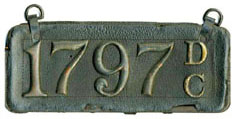 Motor vehicles operated in the District of Columbia were first required to be registered in August of 1903, but their owners were required to make or otherwise procure their own markers in order to display the registration number assigned by the city's Automobile Board. As they were in nearby states, these early homemade plates were often made of leather marked with aluminum house numbers, and mail-order, kit-type metal plates presumably also were used here because they were widely advertised in publications that appealed to automobilists.
Motor vehicles operated in the District of Columbia were first required to be registered in August of 1903, but their owners were required to make or otherwise procure their own markers in order to display the registration number assigned by the city's Automobile Board. As they were in nearby states, these early homemade plates were often made of leather marked with aluminum house numbers, and mail-order, kit-type metal plates presumably also were used here because they were widely advertised in publications that appealed to automobilists.
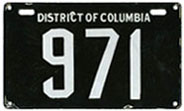 Motorist-provided markers were used until September 1907, when the city began to issue uniform porcelain enamel plates. These undated white-on-black plates were issued and used, with relatively minor design variations, through the end of 1917. Throughout this period license plates and registrations were considered permanent, thus there was no annual renewal process or fee. Furthermore, until 1918 there was only a single motor vehicle registration classification (whereas now there are many: private passenger, commercial, trailer, etc.), but there were two types of license plate because the standard format was found to be unsuitable for use on motorcycles.
Motorist-provided markers were used until September 1907, when the city began to issue uniform porcelain enamel plates. These undated white-on-black plates were issued and used, with relatively minor design variations, through the end of 1917. Throughout this period license plates and registrations were considered permanent, thus there was no annual renewal process or fee. Furthermore, until 1918 there was only a single motor vehicle registration classification (whereas now there are many: private passenger, commercial, trailer, etc.), but there were two types of license plate because the standard format was found to be unsuitable for use on motorcycles.
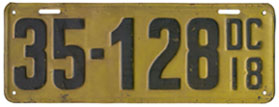 Everything changed for 1918, when D.C. caught up to most of the states, which by that relatively late year had already switched from undated, multi-year plates (if indeed they ever used them several nearby states did not) to annual plates that were accompanied by annual registration fees. Dated, embossed steel plates were introduced for 1918 and were issued annually through early 1942. There is, however, no District of Columbia plate dated "1939" due to the shift, in that year, from a registration year that corresponded to the calendar year to one that began on March 1 and ended at the end of February (which in 1940 was February 29). At that time, data shown on the plate to indicate its period of use was changed from the calendar year of validity ("1938" was the last) to the expiration date ("EX-2-29-40" was the first). Further information about this subject appears below. All 1918 and earlier District of Columbia plates were issued singly; pairs were not used until 1919.
Everything changed for 1918, when D.C. caught up to most of the states, which by that relatively late year had already switched from undated, multi-year plates (if indeed they ever used them several nearby states did not) to annual plates that were accompanied by annual registration fees. Dated, embossed steel plates were introduced for 1918 and were issued annually through early 1942. There is, however, no District of Columbia plate dated "1939" due to the shift, in that year, from a registration year that corresponded to the calendar year to one that began on March 1 and ended at the end of February (which in 1940 was February 29). At that time, data shown on the plate to indicate its period of use was changed from the calendar year of validity ("1938" was the last) to the expiration date ("EX-2-29-40" was the first). Further information about this subject appears below. All 1918 and earlier District of Columbia plates were issued singly; pairs were not used until 1919.
Most distinctive plates for non-passenger vehicles issued through 1934 were marked with a letter prefix, with motorcycle as the only exception, its status being evident in its small size. Motorcycle plates were introduced in 1908, the only non-passenger type issued through 1917. Dealer plates were introduced in 1919, and other types, if not introduced that year, soon followed. H-prefix plates for hire vehicles (taxis) and L-prefix plates for livery vehicles are examples of other early types. Distinctive plates for trucks and trailers came slightly later.
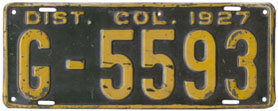 As new plates were issued annually beginning in 1918, numbers were assigned sequentially starting at 1. Those with the lowest numbers were coveted, and in many cases assigned to the same individual year after year. Passenger car registration numbers first exceeded 99-999 during 1923. Officials apparently quickly tired of the resultant six-number format, however, for 1926 was the last year in which all auto plates displayed only numbers. Although the lowest all-numeric combinations were retained for 1927 and thereafter, most plates assigned for 1927 have a letter prefix followed by up to four numbers. Plates issued for use on non-passenger vehicles except motorcycles continued to be marked with a letter prefix. Dealer plates, for example, began with D, as they had since 1919. Truck plates are prefixed by either B or C depending on the registration category, which was determined by the vehicle's weight.
As new plates were issued annually beginning in 1918, numbers were assigned sequentially starting at 1. Those with the lowest numbers were coveted, and in many cases assigned to the same individual year after year. Passenger car registration numbers first exceeded 99-999 during 1923. Officials apparently quickly tired of the resultant six-number format, however, for 1926 was the last year in which all auto plates displayed only numbers. Although the lowest all-numeric combinations were retained for 1927 and thereafter, most plates assigned for 1927 have a letter prefix followed by up to four numbers. Plates issued for use on non-passenger vehicles except motorcycles continued to be marked with a letter prefix. Dealer plates, for example, began with D, as they had since 1919. Truck plates are prefixed by either B or C depending on the registration category, which was determined by the vehicle's weight.
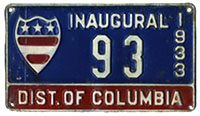 The District of Columbia became the first U.S. jurisdiction to issue a limited-use, short-term plate for a special event when it authorized a distinctive red, white, and blue plate to commemorate the 1933 presidential inauguration. This became a tradition, with the special plates being issued for every inauguration except that of 1945, although recent examples are souvenirs sold by the inaugural committee and in most cases cannot be used on vehicles. A number of other special event plates have been issued, most notably a series of annual plates from 1962 through 1974 that commemorated the National Cherry Blossom Festival.
The District of Columbia became the first U.S. jurisdiction to issue a limited-use, short-term plate for a special event when it authorized a distinctive red, white, and blue plate to commemorate the 1933 presidential inauguration. This became a tradition, with the special plates being issued for every inauguration except that of 1945, although recent examples are souvenirs sold by the inaugural committee and in most cases cannot be used on vehicles. A number of other special event plates have been issued, most notably a series of annual plates from 1962 through 1974 that commemorated the National Cherry Blossom Festival.
As for regular plates assigned to rank-and-file Washingtonians, for the 1940 registration year the period of validity was shifted to April 1-March 30, where it remained until 1984. As occurred in most states, the use of license plates for multiple years was warranted during World War II in order to minimize the use of steel for non-military efforts. In fact, the scarcity of pre-war plates today is due in large part to scrap metal drives conducted during the war. Although many motorists had retained their old plates when mounting new ones in an annual chore, most gladly contributed their obsolete heavy steel markers to help the war effort.
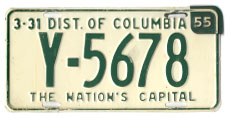 After World War II, Washington D.C. returned to issuing new plates annually, but not exclusively. The 1946 plate was used for two years, like the 1942 plate being revalidated with a small metal tab, and the 1953 plate, the first in D.C. to include a slogan, was also used for two years. It was also for 1953 that D.C. plates were first made in the modern 6x12 format, which is still used today, and when plates returned to being marked with the expiration date. The five previous plates, those of the 1948-49 through 1952-53 registration years, were marked with the year of issue (as discussed below).
After World War II, Washington D.C. returned to issuing new plates annually, but not exclusively. The 1946 plate was used for two years, like the 1942 plate being revalidated with a small metal tab, and the 1953 plate, the first in D.C. to include a slogan, was also used for two years. It was also for 1953 that D.C. plates were first made in the modern 6x12 format, which is still used today, and when plates returned to being marked with the expiration date. The five previous plates, those of the 1948-49 through 1952-53 registration years, were marked with the year of issue (as discussed below).
After the two-year 1953 (3-31-54) plate was replaced in early 1955, another 11 annual issues were used before the switch back to multi-year plates, now validated with stickers, was made for good. It was during this period, in early 1962, that the District's first reflectorized plate was issued. D.C officials seemed to struggle with an appropriate general-issue numbering format during this period, using AB-12-34 for two years (1955 and 1956); AB-123 for the next seven (1957-1963); 1A234 (and 1A23 when they ran out of numbers) for 1964; and 1AB23 for 1965, finally settling on an all-number format, beginning at 100-000, for 1966.
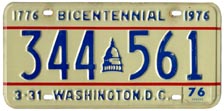 In April 1966 the first of seven successive multi-year plates, which have brought us through to the present day, was introduced. The plain black-on-white 1966 plate was used for two years, replaced in 1968 by a new plate surprisingly similar in appearance. It was replaced six years later by a relatively well-known plate with 1776 BICENTENNIAL 1976 across the top, the first to use the basic design still used today, with blue figures on a white background accented by two horizontal red rules stretching across the plate. This is one of the first two U.S. plates to be made with graphic reflective sheeting, which is now used throughout North America. (South Dakota also introduced a plate made with graphic sheeting for 1974.)
In April 1966 the first of seven successive multi-year plates, which have brought us through to the present day, was introduced. The plain black-on-white 1966 plate was used for two years, replaced in 1968 by a new plate surprisingly similar in appearance. It was replaced six years later by a relatively well-known plate with 1776 BICENTENNIAL 1976 across the top, the first to use the basic design still used today, with blue figures on a white background accented by two horizontal red rules stretching across the plate. This is one of the first two U.S. plates to be made with graphic reflective sheeting, which is now used throughout North America. (South Dakota also introduced a plate made with graphic sheeting for 1974.)
All owners of private vehicles registered in Washington received new license plates for their cars during March of 1974, and again ten years later. The plate introduced in the interim, in 1978, was used only for new registrations. It was that 1984 plate, however, marked A Capital City , that was the last to be distributed to everyone. Those 1984 plates are still in use, and plates adorned with new slogans unveiled since then, such as Celebrate & Discover in 1991 and Taxation Without Representation in 2000, have been provided only to those purchasing a new registration (or that deliberately replaced their older plates with new ones).
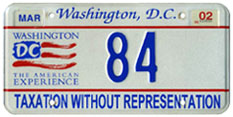 Contrary to the standard practice (in Washington and elsewhere) of using license plates for multiple years, one of several plate-related characteristics, past and present, that makes D.C. unique is that here there is still a portion of the motoring population that receives a new pair of plates annually. Whereas this annual replacement used to occur in all of the states, annual plates were abandoned decades ago in favor of multi-year issues everywhere except for D.C., and specifically for individuals to whom the city's 1,250 lowest registration numbers are assigned. In recent years these special annual issues have been characterized by a variety of graphic treatments.
Contrary to the standard practice (in Washington and elsewhere) of using license plates for multiple years, one of several plate-related characteristics, past and present, that makes D.C. unique is that here there is still a portion of the motoring population that receives a new pair of plates annually. Whereas this annual replacement used to occur in all of the states, annual plates were abandoned decades ago in favor of multi-year issues everywhere except for D.C., and specifically for individuals to whom the city's 1,250 lowest registration numbers are assigned. In recent years these special annual issues have been characterized by a variety of graphic treatments.
A phenomenon that began during the U.S. bicentennial era of allowing motorists to pay extra for a plate with an alternative graphic design, some of which promote colleges and universities, not-for-profit organizations, and other causes, was introduced to D.C. residents in 1991 with a colorful design that promotes the city's bicentennial. While the number of optional plates made available here pales in comparison to many of the states, most notably neighbors Maryland and Virginia, there are presently several. Some are available to all motorists, others only to individuals affiliated with particular institutions or organizations.
Washington's current plates, with their unusual TAXATION WITHOUT REPRESENTATION slogan, have kept up with the times. The use of plate validation stickers was abandoned in 2002 in favor of a larger sticker displayed on the inside of the vehicle's windshield, and plates current being issued are completely flat, made with Digital License Plate technology.
Here is one example of the many characteristics of D.C. plates that confuse observers today: the manner in which the period of use was marked on them from the late 1930s through (at least) the mid-1970s. Shown and explained are three sets of passenger plates issued for two consecutive registration periods.
 |
||
1938 (top) and 1939 plates |
1947 (top) and 1948 plates |
1952 (top) and 1953 plates |
1938 and 1939. The era of D.C. plates that is easiest to understand today is the 21-year period from 1918 through 1938, when plates were used for 12-month periods that corresponded to the calendar year marked on them.
A decision had apparently been made by early-to-mid 1938 (by which time production of plates for the following year would have had to have commenced) to change the registration year from the calendar year to a twelve-month period beginning March 1 and ending on the final day of February. In order to accomplish the transition, the plate that would have been marked "1939" under the old system is instead marked "EX-2-29-40," the decision having been made to display the date of expiration, not the year of issue, on plates issued for the new period.
To further confuse matters, the March-February registration year was used for only one year. Thereafter (until 1984), an April 1-March 31 period was used. Therefore:
-
The 1938 plate, marked "1938," was used for 12 months, Jan. 1 to Dec. 31, 1938,
-
The 1939 plate, marked "EX-2-29-40," was used for 14 months, from Jan. 1, 1939 to Feb. 29, 1940,
-
The 1940 plate, marked "EX-3-31-41," was used for 13 months, from March 1, 1940 to March 31, 1941, and
-
The 1941 plate, marked "EX-3-31-42," was used for 12 months, from April 1, 1941 to March 31, 1942.
1947 and 1948. For most of the 40+ years that the registration year remained unchanged (April 1 through March 31) a plate's period of validity was indicated with the expiration date. However, for a five-year period the year of issuance, not date of expiration, was shown. In order to accomplish the transition, upon the March 31, 1948, expiration of a plate marked (with a validation tab) "EX-3-31-48," a plate dated "1948" was issued and used until March 31, 1949. Four additional plates dated in this manner were used, the last being marked "1952" and used until March 31, 1953.
1952 and 1953. At the end of the five year-period described immediately above during which plates were embossed with the year of issuance, the manner of marking plates reverted to the expiration date method. To accomplish this change, expiration of the dated "1952" plate on March 31, 1953, was followed by the issuance of plates marked "3-31-54."
| Sept. 1893 | The first practical (by standards of the day) self-propelled vehicle made in the United States is operated in Springfield, Mass., by the Duryea brothers. | |
| 1897 | The first U.S. companies formed for the production of automobiles are organized. | |
| Jan. 1901 | D.C. superintendent of police Maj. Richard Sylvester suggests to the commissioners that a vehicle registration program be instituted. A corresponding Senate bill failed to pass. |
|
| Apr. 1901 | New York becomes the first state to require that motor vehicles be registered. Vehicle owners are required to provide their own plates that bear their initials. | |
| Apr. 1903 | An Automobile Board is formed to administer the District's first motor vehicle registration law. | |
| Aug. 1903 | The first registration law takes effect, with numbers assigned sequentially beginning at 1, but vehicle owners have to provide their own plates. | |
| Oct. 1907 | The era of homemade owner-provided D.C. plates comes to an end, when uniform porcelain enamel plates procured by the Automobile Board began to be issued. There is no registration fee, and each motorist is charged $1 for their new white-on-black marker. | |
| Apr. 1908 | Special license plates for use on motorcycles are introduced. | |
| Dec. 1917 | The District's porcelain era comes to a close. About 60,000 white-on-black porcelain plates were issued from 1907 through 1917. | |
| Jan. 1918 | Dated, embossed steel license plates, and annual registration fees, are introduced. | |
| Jan. 1919 | D.C. plates are first issued in pairs. Plates with a D prefix are introduced for automobile dealers, the earliest known non-passenger plates other than those made for use on motorcycles. | |
| late 1923 | D.C. private passenger plates reach number 100-000. | |
| Jan. 1927 | The numbering configuration for most passenger car plates is changed from an all-numeric format to one letter followed by up to four numbers, although plain numbers 1-1000 remain in use. | |
| Jan. 1930 | The quantity of available all-numeric passenger car plates is increased from 1,000 to 9,999. | |
| Mar. 1933 | The first special-event plate in the United States is issued (although not to the general public) to commemorate the inauguration of Pres. Franklin D. Roosevelt. | |
| Jan. 1935 | The numbering configuration of most D.C. plates is changed, with passenger car registrations reverting to an all-numeric format and non-passenger plates being marked with the type name rather than being identified by a letter prefix. | |
| Jan. 1936 | Passenger car plates 1 through 9999 are made in a new, smaller format compared to other plates. | |
| Jan. 1939 | The first plates to be marked with their expiration date, not the year of issue, are introduced as the registration year is changed from a 12-month period corresponding to the calendar year to a March 1-Feb. 28 (or 29) period. | |
| Mar. 1940 | The registration year is changed again, to April 1-March 31, a change reflected on plates that continue to be marked with the expiration date, not the year of issue. | |
| Apr. 1942 | The first multi-year plate used since the porcelain era is introduced. The 1942 plate, marked EXP-3-31-43, is used for three years, revalidated for the 1943 and 1944 registration years with small metal tabs marked 44 and 45, respectively. | |
| Apr. 1945 | The first D.C. plates issued singly since 1919 are introduced due to metal conservation efforts during World War II. | |
| Apr. 1948 | The method of marking D.C. plates is changed, with the year of issue (1948 in this case) being displayed. Also, the size of all passenger car plates is again uniform, which is to say that plates 1 through 9999 are no longer shorter than plates with a registration number comprised of five characters. | |
| Jan. 1951 | Special Use plates are introduced. | |
| Apr. 1953 | The District's first plate to include a slogan, The Nation's Capital, are issued. These green-on-white plates mark the return to the period of use being indicated by the expiration date, and the introduction of the now-standard 6x12 uniform size for plates of most types. | |
| Apr. 1955 | Likely in response to the numbering of Maryland plates, D.C. adopts a general-issue passenger configuration of AB-12-34, which turned out to be used for only two years. | |
| The quantity of available all-number passenger registrations is reduced from 9,999 to 1,000. | ||
| Feb. 1957 | A special series of bus plates for sightseeing buses is introduced. | |
| Apr. 1957 | A new general-issue numbering configuration, AB-123, is adopted, and is used for seven years. | |
| The quantity of available all-number passenger registrations is increased from 1,000 to 1,200. | ||
| Mar. 1958 | Special license plates for use on antique automobiles are introduced. | |
| Apr. 1960 | The quantity of available all-number passenger registrations is increased from 1,200 to its present level of 1,250. | |
| Apr. 1962 | License plates with a reflectorized background are introduced. | |
| The first in a series of special plates to commemorate the National Cherry Blossom Festival is issued. | ||
| License plates issued to vehicle dealers begin to be issued singly in order to combat the illegal use of both plates of a pair simultaneously on two different vehicles. | ||
| Apr. 1965 | "Washington, D.C." appears on passenger car plates for the first time. | |
| A second series of specially-marked license plates for representatives of foreign governments based in Washington, marked with a prefix of WN, is introduced to supplement the existing series of DPL-prefix plates. | ||
| Apr. 1966 | A general-issue passenger registration number configuration comprised of six numbers, which was ultimately used for 31 years, is introduced. Dies introduced at this time were used for 35.5 years, when flat plates were introduced. | |
| Apr. 1967 | The first plate validation stickers, marked "68," are issued, beginning a 20-year period during which is employed an unusual system of affixing to plates issued for new registrations (i.e. not renewals) a sticker with a serial number that corresponds to the registration number. | |
| Apr. 1968 | Aluminum license plates are introduced, although plates of some non-passenger types continued to be made of steel. | |
| Apr. 1969 | The city name is changed to "Washington, D.C." on dealer plates, four years after this alteration was made on plates of most (if not all) other types. | |
| Apr. 1970 | The unusual and unprecedented (anywhere in the U.S.) practice of having validation stickers properly displayed in the center of a plate, not in one of the corners, is introduced. | |
| Apr. 1974 | New plates introduced for all vehicle owners are covered with reflective sheeting imprinted with two red horizontal rules, only the second U.S. plate to be made with reflective sheeting (after the 1974 South Dakota plate, issued three months earlier). Also employed at this time is a new slogan, chosen to commemorate the U.S. bicentennial. | |
| The final National Cherry Blossom Festival special-event plate is issued. | ||
| 1975 | The District of Columbia becomes the only U.S. jurisdiction to issue distinctive license plates to members of the clergy. | |
| Apr. 1978 | With the bicentennial year now history, the license plate slogan is changed back to "Nation's Capital." Plates of this new base are made with an expiration month designation sticker, marked "3-31," applied during the manufacturing process before the plates are clear-coated, which is unusual, and likely unprecedented. | |
| Feb. 1979 | The registration type Historic Motor Vehicle is introduced, replacing Antique Car. | |
| Mar. 1984 | District vehicle owners experience their last annual registration renewal month during which all regstrations expire, as a staggered renewal system is introduced. | |
| Oct. 1984 | A new, graphic baseplate bearing a new slogan, "A Capital City," is introduced. The earliest plates, numbered beginning at 010-001, are the first ever to include a leading zero. The embossed Capitol dome motif is replaced by a graphic image of the D.C. flag. | |
| mid-1987 | The system under which validation stickers applied to plates issued for new registrations have a serial number that corresponds to the plate number is abandoned. | |
| Jul. 1991 | The slogan"Celebrate & Discover" is introduced. | |
| Apr. 1997 | A new general-issue passenger registration numbering configuration, AB-1234, is introduced. | |
| Nov. 2000 | The slogan "Taxation Without Representation" is introduced. | |
| Apr. 2001 | The first in a series of unique graphic designs for reserved-number passenger car plates is introduced. | |
| Sept. 2001 | Flat plates, made with DLP (Digital License Plate) technology, are introduced for passenger car registrations. Non-passenger plates with an embossed registration number continue to be issued until supplies are depleted. | |
| Apr. 2002 | The issuance of plate validation stickers ceases, and the validity of registrations begins to be marked with a sticker affixed to the inside of the vehicle's windshield. | |
| Nov. 2004 | Multi-year dealer plates that resembled plates of other designs are replaced with a white-on-red plate that clearly was designed to stand out when in use. New plates, in a different, noticeable color scheme, have since been issued annually for use beginning on November 1. | |
| Special license plates for vehicle manufacturers are introduced. | ||
| Feb. 2011 | Hire (Taxi) becomes the first non-passenger type with plates numbered with a letter prefix followed by up to five numbers that surpasses the 99,999th registration since this numbering configuration was introduced for several types with plate number 101 (e.g. H-101 for this particular type) in 1974. After plate number H-99999, the type code letter was moved to the right, with new registrations beginning at either 00000-H or 00001-H. | |
| Mar. 2013 | Plates marked with DISTRICT OF COLUMBIA instead of WASHINGTON, D.C. begin to be issued. The change, reflected in general-issue auto plates beginning in July 2013, was made gradually as supplies of older plates of various types were depleted. As of Oct. 2014 the city name had been displayed as "District of Columbia" or some abbreviated version thereof for 58-2/3 years, or 54.8%, of the 107 years during which uniform plates had by then been issued. | |
| Apr. 2016 | Six-number passenger car plates still in use are replaced by new flat plates. This process removed from service any remaining 1984 base "Capital City" plates as well as the earliest 1991 "Celebrate and Discover" plates. |
|
This page last updated on December 31, 2017 |
 |
|
copyright 2006-2018 Eastern Seaboard Press Information and images on this Web site may not be copied or reproduced in any manner without consent of the owner. For information, send an e-mail to admin@DCplates.net |














